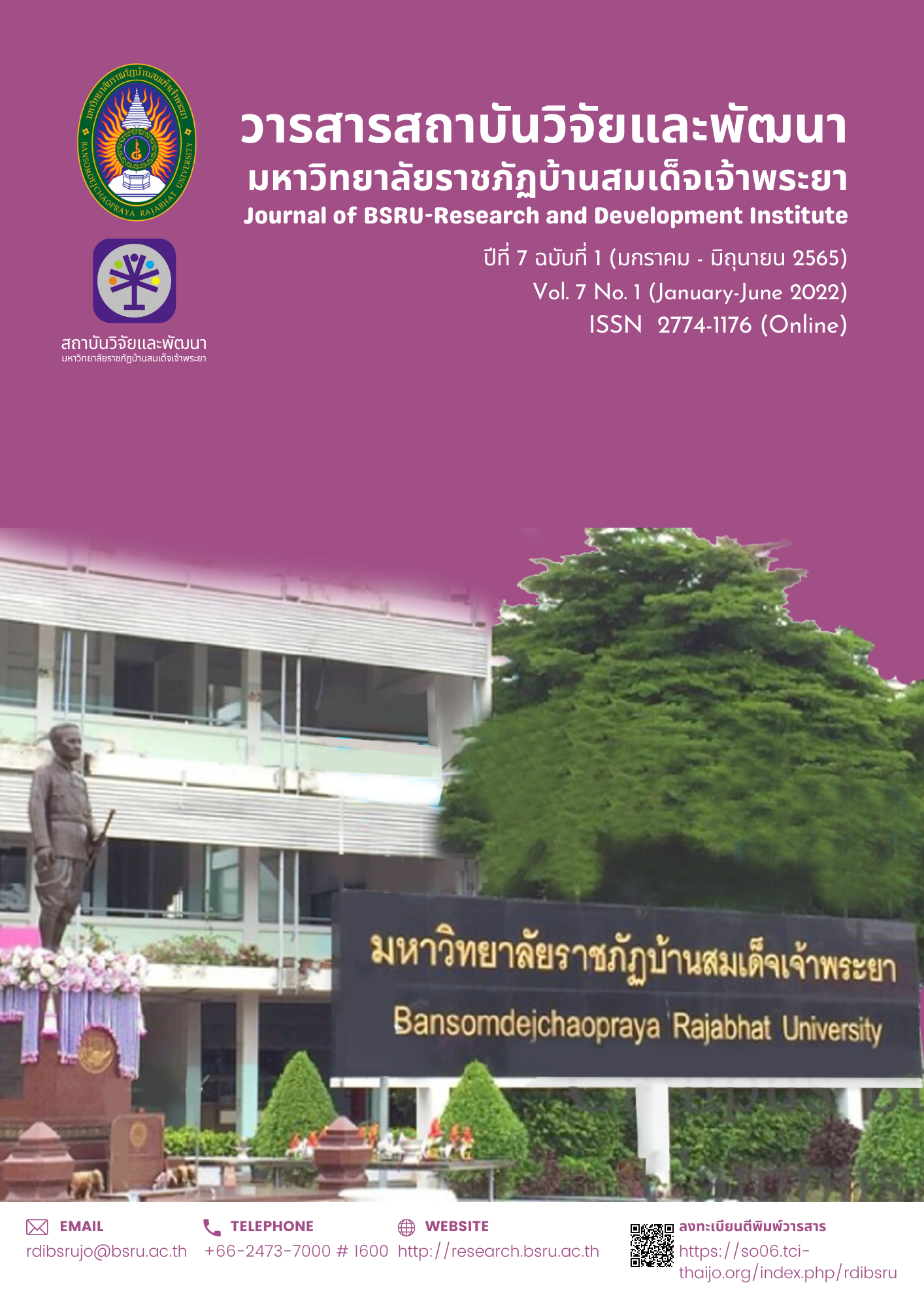ประสิทธิภาพของสารสกัดหยาบจากสมุนไพรในการยับยั้งเชื้อรา Phytophthora parasitica
คำสำคัญ:
สารสกัดหยาบจากสมุนไพร, การยับยั้งเชื้อรา, ไฟทอฟธอรา พาราซิติกาบทคัดย่อ
การวิจัยนี้มีวัตถุประสงค์เพื่อทดสอบและเปรียบเทียบประสิทธิภาพของสารสกัดหยาบจากพืชสมุนไพร 3 ชนิด คือ สะเดา ชะพลู และขิง ในการยับยั้งเชื้อรา Phytophthora parasitica ด้วยวิธี agar well diffusion บนอาหาร potato dextrose agar (PDA) ที่ระดับความเข้มข้น 100 50 20 10 และ 5 มิลลิกรัมต่อมิลลิลิตร โดยใช้เวลาในการทดสอบ 3 5 และ 7 วัน ทำการทดลองเปรียบเทียบกับชุดควบคุมเชิงบวก คือ สาร mancozeb ผลการทดลองพบว่าสารสกัดหยาบจากสมุนไพรทั้ง 3 ชนิด สามารถยับยั้งเชื้อรา P. parasitica ได้ดีที่สุดในวันทดสอบที่ 3 ที่ระดับความเข้มข้น 100 มิลลิกรัมต่อมิลลิลิตร และเมื่อเปรียบเทียบประสิทธิภาพการยับยั้งเชื้อรา P. parasitica พบว่าทุกสารทดสอบไม่มีความแตกต่างกันอย่างมีนัยสำคัญ (p≤0.05) โดยสารสกัดจากขิงมีประสิทธิภาพการยับยั้งดีที่สุดเท่ากับ 73.59±2.48 เปอร์เซ็นต์ รองลงมาคือสารสกัดจากสะเดาเท่ากับ 72.05±2.85 เปอร์เซ็นต์ และสารสกัดจากชะพลูเท่ากับ 70.01±5.03 เปอร์เซ็นต์ ตามลำดับ
Downloads
เอกสารอ้างอิง
จาณียา ขันชะลี, ศศิประภา คำหงส์, สง่า ผลอ้อ, ศิรประภา การันต์, อนุสราถามะพันธ์ และวรพล สุรพัฒน์. (2555). การศึกษาผลของสารสกัดสมุนไพรพื้นบ้านในการรักษาโรคที่เกิดจากเชื้อราในยางพารา. การประชุมทางวิชาการของมหาวิทยาลัยเกษตรศาสตร์ ครั้งที่ 50. หน้า 214-221. สำนักงานกองทุนสนับสนุนการวิจัย.
ปิยรัตน์ นามเสนา. (2557). คุณสมบัติการยับยั้งเชื้อรา Alternaria brassicicola ของสารสกัดหยาบจากใบพืช. รายงานการวิจัย สถาบันวิจัยและพัฒนา มหาวิทยาลัยราชภัฎมหาสารคาม.
วนิดา ชื่นชัน, สุกันยา รักษาสระน้อย, สมศักดิ์ อยู่บริบูรณ์, และวรรณกร กิจจะ. (2562). การยับยั้งเชื้อรา Phytophthora parasitica ด้วยเชื้อราปฏิปักษ์ที่แยกได้จากดินในเขตพื้นที่ ตำบลกุยบุรี จังหวัดประจวบคีรีขันธ์. วารสารวิทยาศาสตร์ลาดกระบัง, 28(1), 52-64.
วาสินี ธรรมสถิต, สุจิตรา สุคนธมัต และ ดุษณี ธนะบริพัฒน. (2560). การคัดเลือกสมุนไพรที่มีฤทธิ์ควบคุมเชื้อรา Phytopthora sp. ที่แยกจากทุเรียนในจังหวัดจันทบุรีและจังหวัดชุมพร. วารสารวิทยาศาสตร์ลาดกระบัง, 26(2), 1-14.
วีระเดช คชเสนีย์. (2560, 2 พฤศจิกายน). กรมวิชาการเกษตรแนะวิธีรับมือ “โรครากเน่าโคนเน่า ในทุเรียน”. สำนักข่าว กรมประชาสัมพันธ์. สืบค้นจากhttps://thainews.prd.go.th/th/news/print_news/TNEVN6011020010008
สมชาย บุญประดับ. (2558). การศึกษาผลกระทบและพัฒนาเทคโนโลยีการจัดการผลผลิตด้านเกษตรภายใต้สภาวะการเปลี่ยนแปลงภูมิอากาศในประเทศไทย. รายงานโครงการวิจัย. กรมวิชาการเกษตร: กรุงเทพฯ.
Gamaliel, A., Katan, J., & Conen, E. (1989). Toxicity of chloronitrobemzenes to Fusarium oxysporum and Rhizoctonia solani as related to their structure. Phytoparasitica, 17, 101-106.
Ghasemzadeh, A., Jaafar, H., & Rahmat, A. (2010). Synthesis of Phenolics and Flavonoids in Ginger (Zingiber officinale Roscoe) and Their Effects on Photosynthesis Rate. International Journal of Molecular Sciences, 11(11), 4539-4555. doi:10.3390/ijms11114539
Green, J., & Nelson, S. (2015). Heart and Root Rots of Pineapple. Plant Disease, 106, 1-7.
Jagtap, G.P., Thosar, R.U., & Utpal, D. (2012). Evaluation of plant extracts and bioagents for the control of gummosis of mandarin orange (Citrus reticulata blanko) caused by Phytophthora species. African Journal of Agricultural Research, 7(32), 4553-4558, doi: 10.5897/AJAR12.214
Jerobin, J., Makwana, P., Suresh Kumar, R.S., Sundaramoorthy, R., Mukherjee, A., & Chandrasekaran, N. (2015). Antibacterial activity of neem nanoemulsion and its toxicity assessment on human lymphocytes in vitro. International Journal of Nanomedicine, 10, 77-86. doi:10.2147/IJN.S79983.
Joy, P.P., & Sindhu, G. (2012). Pineapple Research Station (Kerala Agricultural University), Vazhakulam-686 670. Retrieved from https://www.kau.edu/prsvkm.
Kalhoro, M., Zhang, H., Kalhoro, G.M., Wang, F., Chen, T., Faqir, Y., & Nabi, F. (2022). Fungicidal properties of ginger (Zingiber ofcinale) essential oils against Phytophthora colocasiae. Scientifc Report, 12, 1-10. Retrieved from https://doi.org/10.1038/s41598-022-06321-5
Melo, T.A. de, Serra, I.M.R. de S., & Nascimento, I.T.V. da S. do. (2021). Effect of hydroalcoholic neem (Azadirachta indica) extract and oil on the fungus Fusarium oxysporum f. sp. vasinfectum and in the induced resistance of okra to fusariosis. Research, Society and Development, 10(2), 1-19. e7110212357. Retrieved from https://doi.org/10.33448/rsd-v10i2.12357
Nawrot-Chorabik, K. (2013). The use of interactions in dual cultures in vitro to evaluate the pathogenicity of fungi and susceptibility of host plant genotypes. In M. Petre (Ed.), Environmental biotechnology-new approaches and prospective applications. doi:10.5772/53214.
Pente, R., Gade, R.M., Belkar, Y.K., & Shinde, P. (2015). Evaluation of Botanicals and Bioagents against Phytophthora Root Rot in Citrus. Trends in Biosciences, 8(3), 752-758.
Rohrbach, K.G., & Schenck, S. (1985). Control of pineapple heart rot, caused by Phytophthora parasitica and P. cinnamomi, with metalaxyl, fosetyl Al, and phosphorous acid. Plant Disease, 69, 320-323.
Tongchure, S., & Chanprapai, P. (2022). Antifungal properties of the essential oils derived from three plants of Zingiberaceae family against Phytophthora parasitica Dastur. In Proceedings of the 1st International online conference on agriculture-advances in agricultural science and technology, 10-25 February 2022, MDPI:Basel, Switzerland, doi:10.3390/IOCAG2022-12324.
Turkolmez, S., & Dervis, S. (2017). Activity of metalaxyl-M+mancozeb, fosetyl-Al, and phosphorous acid against Phytophthora crown and root rot of apricot and cherry caused by Phytophthora palmivora. Plant Protection Science, 53, 216–225.
Ugusman, A., Zakaria, Z., Hui, C.K., Nordin, N.A., & Mahdy, Z.A. (2012). Flavonoids of Piper Sarmentosum and Its Cytoprotective Effects Against Oxidative Stress. EXCLI Journal, 11, 705-714. doi:10.17877/DE290R-10356
ดาวน์โหลด
เผยแพร่แล้ว
ฉบับ
ประเภทบทความ
สัญญาอนุญาต
บทความ ข้อความ ภาพประกอบ และตารางประกอบที่ลงพิมพ์ในวารสารเป็นความคิดเห็นส่วนตัวของผู้นิพนธ์ กองบรรณาธิการไม่จำเป็นต้องเห็นตามเสมอไป และไม่มีส่วนรับผิดชอบใดๆ ถือเป็นความรับผิดชอบของผู้นิพนธ์เพียงผู้เดียว






